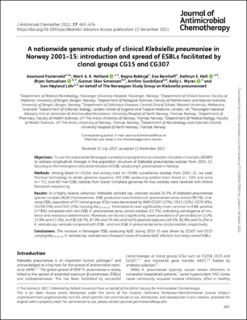A nationwide genomic study of clinical Klebsiella pneumoniae in Norway 2001–15: introduction and spread of ESBLs facilitated by clonal groups CG15 and CG307
Fostervold, Aasmund; Hetland, Marit Andrea Klokkhammer; Bakksjø, Ragna-Johanne; Bernhoff, Eva; Holt, Kathryn E.; Samuelsen, Ørjan; Simonsen, Gunnar Skov; Sundsfjord, Arnfinn; Wyres, Kelly L.; Löhr, Iren Høyland
Journal article, Peer reviewed
Published version

Åpne
Permanent lenke
https://hdl.handle.net/11250/2990556Utgivelsesdato
2022Metadata
Vis full innførselSamlinger
- Department of Clinical Science [2318]
- Registrations from Cristin [9791]
Sammendrag
Objectives
To use the nationwide Norwegian surveillance programme on resistant microbes in humans (NORM) to address longitudinal changes in the population structure of Klebsiella pneumoniae isolates from 2001–15, focusing on the emergence and dissemination of ESBL-producing K. pneumoniae in Norway.
Methods
Among blood (n = 6124) and urinary tract (n = 5496) surveillance isolates from 2001–15, we used Illumina technology to whole genome sequence 201 ESBL-producing isolates from blood (n = 130) and urine (n = 71), and 667 non-ESBL isolates from blood. Complete genomes for four isolates were resolved with Oxford Nanopore sequencing.
Results
In a highly diverse collection, Klebsiella variicola ssp. variicola caused 24.5% of Klebsiella pneumoniae species complex (KpSC) bacteraemias. ESBL production was limited to K. pneumoniae sensu stricto (98.5%). A diverse ESBL population of 57 clonal groups (CGs) were dominated by MDR CG307 (17%), CG15 (12%), CG70 (6%), CG258 (5%) and CG45 (5%) carrying blaCTX-M-15. Yersiniabactin was significantly more common in ESBL-positive (37.8%) compared with non-ESBL K. pneumoniae sensu stricto isolates (12.7%), indicating convergence of virulence and resistance determinants. Moreover, we found a significantly lower prevalence of yersiniabactin (3.0%, 37.8% and 17.3%), IncFIB (58.7%, 87.9% and 79.4%) and IncFII plasmid replicons (40.5%, 82.8% and 54.2%) in K. variicola ssp. variicola compared with ESBL- and non-ESBL K. pneumoniae sensu stricto isolates, respectively.
Conclusions
The increase in Norwegian ESBL-producing KpSC during 2010–15 was driven by CG307 and CG15 carrying blaCTX-M-15. K. variicola ssp. variicola was a frequent cause of invasive KpSC infection, but rarely carried ESBLs.
